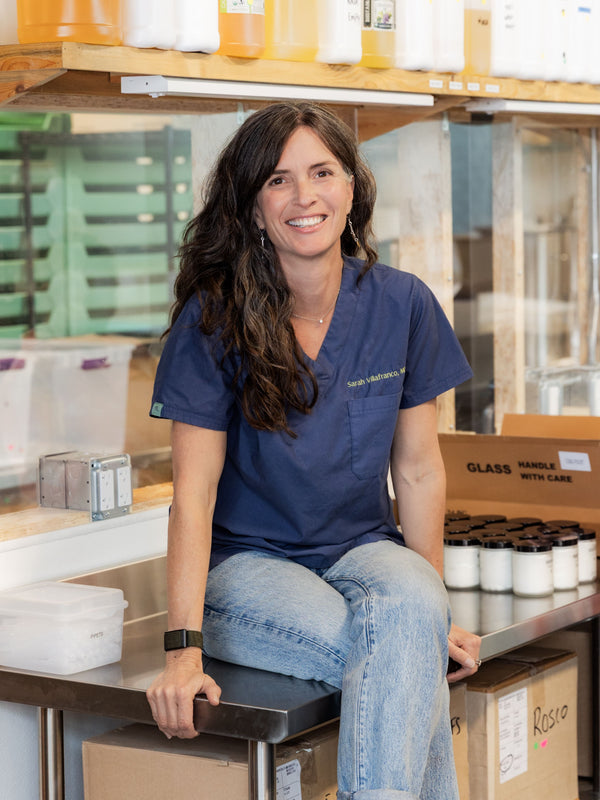Here we are, asking the retinol question again! Let me give you the straight answer: there is no straight answer. So let’s focus on the other questions instead, and then you can see what feels right for you.
What is Vitamin A?
Natural sources of dietary Vitamin A, also called retinoids, come from both animal and plant sources. Animal-derived retinoids—such as retinol, retinal, and retinyl esters—are found in liver, some fish, egg yolks, heavy cream, and butter. Plant-derived Vitamin A comes in the form of carotenoid provitamins, like beta-carotene, found in carrots, sweet potatoes, cantaloupe, kale, and broccoli. These carotenoids must be converted by the body into a usable form of Vitamin A.
Once converted, Vitamin A plays a crucial role in reproductive development, vision, immune function, and the healthy division and differentiation of cells. One of the earliest symptoms of deficiency is night blindness. (Fun fact: the ancient Egyptians treated night blindness by eating liver—turns out they were onto something.)
Vitamin A in Skincare
In the world of skincare, Vitamin A shows up under many names. Retin-A (tretinoin) was the first patented version of a cream containing retinoic acid. Originally developed to treat acne, it surprised dermatologists by also significantly improving the appearance of aging skin.
How Vitamin A Benefits the Skin
Retinoids are among the most studied ingredients in dermatology. Clinical research—including randomized, double-blind, controlled trials—has demonstrated that topical retinoids have the following benefits:
-
Increased cell turnover, resulting in fewer breakouts, improved skin tone, and a more radiant complexion
-
Stimulation of collagen production and slowing of collagen breakdown, leading to firmer skin and reduced appearance of fine lines and wrinkles
-
Increased levels of glycosaminoglycans (GAGs), which enhance skin hydration and resilience
These benefits make retinoids one of the few skincare ingredients that dermatologists almost universally agree actually work.
Potential Side Effects of Retinoids
While retinoids can deliver excellent results, they also come with downsides.
First, there’s the question of toxicity. Although there’s no conclusive evidence that topical retinoids are carcinogenic or teratogenic in humans when used in small amounts, they are not recommended during pregnancy. That alone gives many people pause. If you're pregnant or trying to conceive, it's best to avoid them altogether.
Second, the side effects can be uncomfortable. Red, flaky, tight, irritated skin is common, especially in the first weeks of use. While lower concentrations and reduced application frequency can help, some skin types simply don’t tolerate retinoids well.
Third, the inactive ingredients in many formulations can be problematic. Prescription products may contain parabens, PEGs, or BHT, while commercial over-the-counter products often include synthetic fragrance, artificial colors, and petrochemicals.
And then there’s sun sensitivity. Retinoids exfoliate the skin, which can increase vulnerability to UV damage. Ironically, one form of Vitamin A—retinyl palmitate—is used in some sunscreens despite concerns that it may accelerate certain skin cancers when exposed to sunlight. The data is inconclusive, but both the Environmental Working Group and the National Toxicology Program have raised concerns.
Is Retinol Right for Everyone?
Definitely not. Some people simply can’t tolerate it—no matter how carefully they try. People with rosacea, eczema, or very sensitive skin may react poorly. Pregnant or soon-to-be-pregnant women should avoid most retinoid products, as many are classified as Category C (or higher), meaning they caused birth defects in animal studies, even if human data is limited.
Three Ways to Use Vitamin A on Your Skin
If you decide to explore topical Vitamin A, you have three main routes:
-
Prescription retinoids
These deliver the fastest results (within 4–12 weeks) but also carry the greatest risk for irritation. Newer, receptor-specific retinoids like adapalene and tazarotene may be gentler, but they often include preservatives and other ingredients that aren’t ideal. Retin-A Micro comes in very low concentrations and may have a cleaner ingredient list—worth asking your dermatologist about this if you have insurance (it's expensive!). -
Over-the-counter retinol
Retinol is about 20 times less potent than tretinoin and can be unstable unless properly packaged. It’s often combined with BHT or other stabilizers, so read ingredient lists carefully. Retinyl palmitate, another OTC form, has been flagged for potential photocarcinogenicity. -
Natural oils high in carotenoids
Oils like rosehip seed, sea buckthorn berry, argan, black currant, and broccoli seed contain high levels of Vitamin A precursors and antioxidants. They don’t work overnight, but with consistent use over 6–12 months, many people notice improved texture, tone, and clarity—without the irritation.
So... Should You Use Retinol?
That depends entirely on your goals, your skin type, and your comfort level with the ingredients. If you're focused on reversing sun damage or reducing wrinkles and you're not pregnant or sensitive, trying a prescription or OTC retinoid might be worthwhile. If you prefer a slower, more natural, nontoxic approach, botanical oils are a beautiful alternative.
Does Eating Vitamin A Help My Skin?
Yes—just not as directly. While topical application produces more visible skin benefits, a diet rich in carotenoids has been linked to a reduced risk of certain cancers (including breast, ovarian, cervical, and colorectal) and age-related eye diseases. So eat your colorful vegetables! Just skip the high-dose Vitamin A supplements unless prescribed—too much of this fat-soluble vitamin can be toxic.

The information contained in this post is for educational interest only. This information is not intended to be used for diagnosis or treatment of any physical or mental illness, disease, or skin conditions.



















